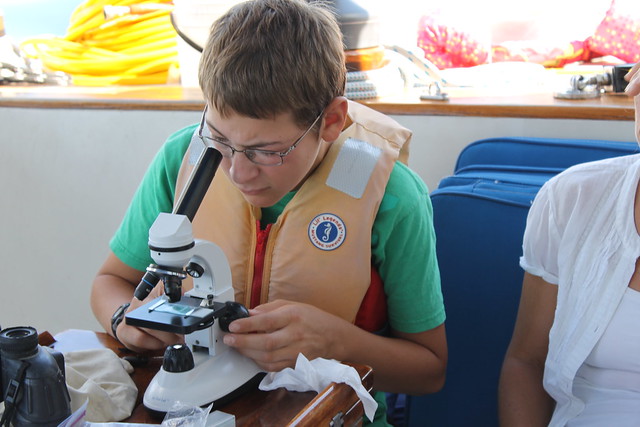Oh, how I look forward to long, boring passages. Really. Time seems to telescope as the instruments count the tenths of nautical miles to the destination. And what shall we do with all this time? Eat very slowly? Talk? Read aloud by the hour? Fish? Watch the fabric of the ocean for the interruption of flying fish or the dolphins of Happiness—or, maybe, if we’re lucky, a whale? Stare lovingly into the deep-blue water and wonder, "what are those specks floating all over the place?" This morning, as we glided over the glassy surface of the Gulf Stream, for lack of anything better to do, I grabbed a bucketful of water, dug the microscope out of the science bin, found some slides, a petri dish, and an eyedropper and opened the Ocean Lab.
This morning’s victim was what I might call a “Floating Puffball from Inner Space.” I suspected it to be algae of some sort. It was a globe of greenish-brown with fine hair sticking out in all directions, about the size of a poppy seed. I sucked it up into the eyedropper and deposited it on a slide in a drop of water. At 40X, it looked like a mass of very fine tangled hair. At 100X, I began to see other, smaller things moving in and out among the hairs, and at 400X, the thing looked like a forest with small animals running in and out of the trees, changing direction mid-stream, diving and flying between the foliage. Each tree trunk was a hair—it was only a few cells thick, and it was clear from the cellular structure that it was plant-kind, but there was movement within each stalk and each moved like a tree waving slowly in a breeze. The tiny one-celled creatures within the forest of algal stems moved with incredible speed and energy. I felt like I was looking at Horton’s Whos down in Whoville. It was mesmerizing.
Once, at a local farmer’s market, I bought a head of heirloom broccoli, not because I wanted to eat it, but because I wanted to look at it up close: its stalk was a perfect spiral staircase of florets, with each floret a perfect spiral of buds, and each bud, in turn, a spiral. It was a perfect fractal repeating to the microscopic level. We have, for school and for fun, looked at inner cheek skin cells (animal), onion skin (vegetable), salt crystals (mineral), a honey bee’s stinger (barbs on barbs!), tiny brine shrimp (with compound eyes), the statue of Lincoln inside his Washington D.C. Memorial (on a penny), no-see-ums (look at those jaws!), hairy spider legs, fleas, and anything else we could capture and study. The C & A Scientific “My First Lab” Duo-Scope portable microscope with battery-operated LED bulbs (allowing you to look at both opaque and translucent objects) is probably the best science purchase we have ever made. It is so easy to use that even the youngest of our children has been able to view the tiny things on the slide—with the instant reward of discovering something strange and new.
The more I stare at that bright circle at the bottom of the dark tube into the magical world of the unseen things, the more I wonder how deep the rabbit hole goes. If a tiny alga can be home to animals as numerous as squirrels in the woods, what else can be possible? I read that we are, by genetic material, only one percent human. That makes me a planet-home to microbes more numerous than the population of humans on earth. Is everything a microcosm—a world inside a world? I feel like a peeping Tom peering in at a Creation too great for my limited intellect. This is usually the point at which I have to put the microscope away and look at the horizon because I suddenly feel a bit dizzy.

